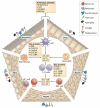The mycobiota: interactions between commensal fungi and the host immune system
- PMID: 24854590
- PMCID: PMC4332855
- DOI: 10.1038/nri3684
The mycobiota: interactions between commensal fungi and the host immune system
Abstract
The body is host to a wide variety of microbial communities from which the immune system protects us and that are important for the normal development of the immune system and for the maintenance of healthy tissues and physiological processes. Investigators have mostly focused on the bacterial members of these communities, but fungi are increasingly being recognized to have a role in defining these communities and to interact with immune cells. In this Review, we discuss what is currently known about the makeup of fungal communities in the body and the features of the immune system that are particularly important for interacting with fungi at these sites.
Figures



References
-
- Tremaroli V, Backhed F. Functional interactions between the gut microbiota and host metabolism. Nature. 2012;489:242–9. - PubMed
Publication types
MeSH terms
Grants and funding
LinkOut - more resources
Full Text Sources
Other Literature Sources
Medical

